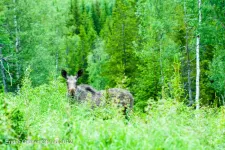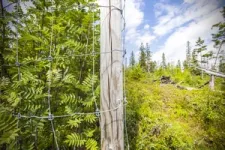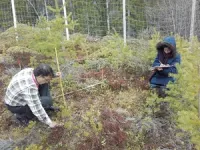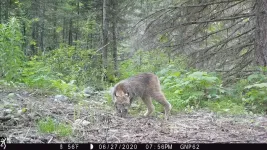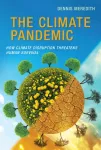(Press-News.org) One of the biggest potential single sources of carbon emissions from wooded parts of Norway has four legs, weighs as much as 400-550 kg and has antlers.
That’s right — moose can reduce carbon storage in clearcut sites equivalent to as much as 60 per cent of the annual fossil fuel carbon emissions from a region, a new study shows.
“Moose are an ecosystem engineer in the forest ecosystem, and strongly impact everything from the species composition and nutrient availability in the forest,” said Gunnar Austrheim, an ecologist at the NTNU University Museum who was one of the study’s co-authors. “A grown animal can eat 50 kilograms of biomass each day during summer.”
That consumption represents roughly 10 per cent of what the Norwegian forest industry itself harvests, he said.
And therein lies the reason why moose can be responsible for such a large additional amount of carbon emissions, said Francesco Cherubini, director of NTNU’s Industrial Ecology (IndEcol) Programme, and co-author of the paper.
Moose influence vegetation growth and more
Moose like to eat young deciduous trees, like birch, rowan and willow. So the young saplings that would normally sprout in the forest after a timber company clearcuts an area never get the chance to grow.
When saplings grow into mature trees, they bind up CO2 in their trunks, leaves and roots. Moose essentially gobble up that possible source of carbon storage.
“It was really a surprise to see how much moose can influence vegetation growth, the carbon cycle and the climate system,” said Xiangping Hu, a researcher at IndEcol and co-author of the study.
Scientists have known that browsing by large animals like moose could be an unaccounted-for source of additional carbon emissions, but there are very few studies with actual numbers to say precisely how much, Hu said.
Filling in the unknowns in climate modelling
Researchers use computer models to try to predict future climate scenarios, based on current and expected emissions of carbon dioxide and other greenhouse gasses.
That’s basically the information we get from the Intergovernmental Panel on Climate Change, or IPCC.
Most recently, the IPCC said humanity is on track to raise the Earth’s average temperate by 2.4 C, which is quite a bit higher than the 1.5 C goal that scientists agree we should aim for.
The challenge is that climate modelling is imperfect. It’s getting better, but there are areas where researchers simply don’t have enough information yet.
They know there are factors that should be in their climate models, but they simply don’t have enough data to include those factors in a realistic way.
The effects of large animals are one of those factors, Cherubini said.
“One of the biggest unknowns that we have in our understanding of the climate system and the carbon cycle is potentially the effect of larger animals, and how they interact with carbon storage in vegetation,” he said.
“This study gave us a great opportunity to quantify this effect,” he said. “We have some numbers that we can relate to the regional carbon budget, and which actually show the importance of large animals like the moose.”
Good for the forest industry, maybe not so good for the climate
The researchers were able to discover the importance of moose on climate as a result of a different, but related study that began in 2008.
At that time, researchers at NTNU and NINA ( the Norwegian Institute for Nature Research) wanted to know what effect moose had on the forest ecosystem after an area had been clearcut. They looked at vegetation regrowth, species diversity and soil nutrient dynamics. Clearcutting is a process where essentially all trees are harvested from an area.
So the researchers set up 47 paired plots in areas that had been clearcut in the previous three years. One of the plot pairs was fenced off so that moose couldn’t browse on the tasty new saplings that naturally spring up after an area has been cut.
The second, nearby plot pair, was open to moose but marked so that researchers could go back year after year to see what happened to tree regrowth and other ecosystem metrics as moose feasted on the vegetation.
What they found was that moose were doing Norway’s forest industry a huge favour, Cherubini said.
“So the forest industry prefers coniferous species, they prefer pine, they prefer spruce. So moose to some extent, are helping them because they’re reducing competition,” by thinning out the deciduous trees and partly pine, leaving the spruce, he said.
Win for the climate, biodiversity and forest management?
The researchers realized they could revisit the plots to study effects on carbon emissions by calculating the differences in aboveground carbon content between browsed and unbrowsed plots.
That enabled them to see potential additional carbon emissions that moose caused by eating deciduous saplings.
Birch and other highly selected deciduous species such as rowan, willow and aspen may also help contribute to the biodiversity of an area, Austrheim said, which moose also affect by removing those species.
So while moose were relatively good for the forest industry, they aren’t necessarily that good for the climate or biodiversity.
But there’s good news.
Finding a balance
Almost all of Norway’s productive forests are harvested using clearcuts.
“These clearcuts provide a lot of good food for moose,” Austrheim said. Moose are also very heavily managed in Norway, he said.
“We don’t only regulate the amount of animals, we very carefully regulate the proportion of females, males and calves. So there’s a stronger management for moose than for most livestock in Norway,” he said.
That means it should be possible to find the right balance between moose numbers and how forested lands are managed. That, in turn, could make it possible to limit excess carbon emissions, boost biodiversity and increase forest productivity, the researchers said.
“I think as we get more of an understanding of how all these different things are interrelated, land managers could come up with an optimal plan,” Cherubini said. “That could be a much needed win-win solution for climate, for biodiversity and for timber value.”
Reference: Salisbury, J., Hu, X., Speed, J. D. M., Iordan, C. M., Austrheim, G., & Cherubini, F. (2023). Net climate effects of moose browsing in early successional boreal forests by integrating carbon and albedo dynamics. Journal of Geophysical Research: Biogeosciences, 128, e2022JG007279. https://doi.org/10.1029/2022JG007279
END
Moose can play a big role in global warming
Browsing by moose can dramatically alter the carbon emissions from boreal forests
2023-03-01
ELSE PRESS RELEASES FROM THIS DATE:
America on the move: How urban travel has changed over a decade
2023-03-01
A new Florida Atlantic University study on America’s urban travel trends shows important variations in travel behaviors across income, home ownership, ethnicity, gender, age, and life-cycle stages. The sixth in a series of studies compared changes in travel modes, trip frequency, trip distance and vehicle ownership among a range of socioeconomic groups using nationwide travel survey data since 1977.
The most notable trend, published in the journal Transportation Research Part D, reveals that although private automobiles continue to be the dominant travel mode in American cities, the share of car trips has slightly and steadily decreased ...
JAMA Network names new editor in chief of JAMA Internal Medicine
2023-03-01
Chicago, March 1, 2023 — Sharon K. Inouye, M.D., M.P.H., Professor of Medicine at Harvard Medical School and the Milton and Shirley F. Levy Family Chair and Director of the Aging Brain Center, Marcus Institute for Aging Research at Hebrew SeniorLife has been named the editor in chief of JAMA Internal Medicine.
An internationally recognized leader in internal medicine, geriatrics, and aging research, Dr. Inouye’s research focuses on delirium and functional decline in hospitalized older patients. She is currently the overall principal investigator of the Successful Aging after ...
Chemotherapy alters immune cell landscape in pancreatic cancer
2023-03-01
Chemotherapy affects the ability of a patient’s immune system to attack pancreatic tumors, a new study shows.
Led by researchers at NYU Langone Health and its Perlmutter Cancer Center, the work revolves around the immune system, which includes T cells designed to attack foreign organisms like viruses. To spare normal cells, the system uses “checkpoint” molecules like PD1 on T cell surfaces to turn off their attack when they receive the right signals. The body also recognizes tumors as abnormal, but cancer cells ...
Dutch healthcare system isn't prepared for pregnant transgender men
2023-03-01
Transgender men can, and often wish to, become pregnant. However, they do need extra guidance and care providers often lack the necessary knowledge and skills. Amsterdam UMC is the first to conduct qualitative research into the experiences of Dutch transgender people with maternity care. This research is now avaliable as a pre-print in Midwifery.
Transgender men often undergo medical procedures to adjust their bodies to their male gender identity. These medical interventions can affect fertility. Some transgender men therefore choose not to undergo these treatments, postpone them or, even, to temporarily stop them. ...
Study shows those with a higher omega-3 index are more protected from severe COVID infection
2023-03-01
A study just published in the American Journal of Clinical Nutrition (AJCN) explored the role of omega-3 fatty acids, especially EPA and DHA, and whether they might be protective against contracting and/or suffering adverse outcomes of COVID-19 infection.
The study compared the risk for three COVID-19 outcomes: 1-testing positive, 2-hospitalization, and 3-death as a function of baseline plasma DHA levels.
DHA levels (% of total fatty acids) were measured by Nuclear Magnetic Resonance (NMR) spectroscopy but were converted to Omega-3 Index (red blood ...
Degrading modified proteins could treat Alzheimer’s, other ‘undruggable’ diseases
2023-03-01
Certain diseases, including Alzheimer’s, are currently considered “undruggable” because traditional small molecule drugs can’t interfere with the proteins responsible for the illnesses. But a new technique that specifically targets and breaks apart certain proteins — rather than just interfering with them — may offer a pathway toward treatment. Researchers reporting in ACS Central Science have, for the first time, designed a compound that targets and breaks down a posttranslationally modified protein closely associated with Alzheimer’s disease.
Researchers have been exploring targeted protein degradation (TPD) as a way to get at ...
Toilet paper is an unexpected source of PFAS in wastewater, study says
2023-03-01
Wastewater can provide clues about a community’s infectious disease status, and even its prescription and illicit drug use. But looking at sewage also provides information on persistent and potentially harmful compounds, such as per- and polyfluoroalkyl substances (PFAS), that get released into the environment. Now, researchers in ACS’ Environmental Science & Technology Letters report an unexpected source of these substances in wastewater systems — toilet paper.
PFAS have been detected in many personal care products, such as cosmetics and cleansers, that people use every day and then wash down ...
Glacier National Park could provide climate haven for Canada Lynx
2023-03-01
PULLMAN, Wash – Glacier National Park is home to around 50 Canada lynx, more than expected, surprising scientists who recently conducted the first parkwide occupancy survey for the North American cat.
The Washington State University-led survey reveals the iconic predator resides across most of Glacier’s 1,600 square-mile landscape, although at lower densities than in the core of its range further north.
“The population in the park is still substantial and exceeded our expectations,” said Dan Thornton, WSU wildlife ecologist ...
Fraunhofer USA awarded patent for detecting air leakage in buildings using communicating thermostats
2023-03-01
The United States Patent and Trademark Office has awarded Fraunhofer USA with a patent for algorithms that detect and quantify air leakage from single-family homes using data from commercially available communicating, thermostats.
Outdoor air can infiltrate homes through many pathways, including windows and doors, poorly sealed connections between exterior walls and basements and attics, and unsealed wall, floor, and ceiling penetrations in occupied spaces. Prior field studies have found that most homes have appreciable air leakage, which accounts for approximately a quarter of space conditioning energy consumption. Not only can air leakage significantly increase home energy consumption, ...
New book warns of human extinction from climate change
2023-03-01
A new book, The Climate Pandemic: How Climate Disruption Threatens Human Survival, concludes that humans will not survive the unrelenting onslaught of climate disruption. The e-book is available free on Amazon March 1-5.
“As horrific as the COVID-19 pandemic has been, its effects pale in comparison to the coming catastrophe from climate disruption,” wrote author and veteran science writer Dennis Meredith. “In fact, the climate pandemic will steadily worsen, even bringing our species to extinction, unless we launch a global revolution to abandon our carbon-dependent energy system.
“Given the evidence in this book, I see only a vanishingly small possibility of ...
LAST 30 PRESS RELEASES:
Heart-brain connection: international study reveals the role of the vagus nerve in keeping the heart young
Researchers identify Rb1 as a predictive biomarker for a new therapeutic strategy in some breast cancers
Survey reveals ethical gaps slowing AI adoption in pediatric surgery
Stimulant ADHD medications work differently than thought
AI overestimates how smart people are, according to HSE economists
HSE researchers create genome-wide map of quadruplexes
Scientists boost cell "powerhouses" to burn more calories
Automatic label checking: The missing step in making reliable medical AI
Low daily alcohol intake linked to 50% heightened mouth cancer risk in India
American Meteorological Society announces Rick Spinrad as 2026 President-Elect
Biomass-based carbon capture spotlighted in newly released global climate webinar recording
Illuminating invisible nano pollutants: advanced bioimaging tracks the full journey of emerging nanoscale contaminants in living systems
How does age affect recovery from spinal cord injury?
Novel AI tool offers prognosis for patients with head and neck cancer
Fathers’ microplastic exposure tied to their children’s metabolic problems
Research validates laboratory model for studying high-grade serous ovarian cancer
SIR 2026 delivers transformative breakthroughs in minimally invasive medicine to improve patient care
Stem Cell Reports most downloaded papers of 2025 highlight the breadth and impact of stem cell research
Oxford-led study estimates NHS spends around 3% of its primary and secondary care budget on the health impacts of heat and cold in England
A researcher’s long quest leads to a smart composite breakthrough
Urban wild bees act as “microbial sensors” of city health.
New study finds where you live affects recovery after a hip fracture
Forecasting the impact of fully automated vehicle adoption on US road traffic injuries
Alcohol-related hospitalizations from 2016 to 2022
Semaglutide and hospitalizations in patients with obesity and established cardiovascular disease
Researchers ‘listen in’ to embryo-mother interactions during implantation using a culture system replicating the womb lining
How changing your diet could help save the world
How to make AI truly scalable and reliable for real-time traffic assignment?
Beyond fragmented markets: A new framework for efficient and stable ride-pooling
Can shape priors make road perception more reliable for autonomous driving?
[Press-News.org] Moose can play a big role in global warmingBrowsing by moose can dramatically alter the carbon emissions from boreal forests
